Introduction
This technical note is intended to enable highways engineers and estimators to make a cost and carbon saving comparison between the two methods of highway edge drainage as detailed in the Specification for Highways Works manual, Series 500.
The drainage works design manual details the use of Type 6 Fin Drains to collect and channel seepage water at carriageway edges (clause 514). This represents an alternative to the Fin Drain Type 8 application (clause 515) detailing a perforated drainage pipe wrapped in geotextile and bedded to the base of a filter stone trench. Both methods require a BBA certificate.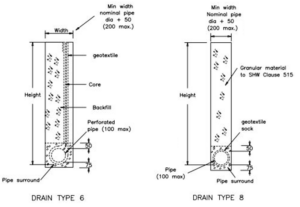
Fildrain Type 6 & Fin Drain Type 8 Comparison
The ABG Fildrain Type 6 geocomposite solution for highway edge drainage is supplied in two parts – a perforated corrugated pipe and a double cuspated HDPE core bonded to a geotextile filter with an integral sleeve to accept a 100mm carrier pipe. The product is developed specifically for use in carriageway drainage applications to manage sub-surface water flow. Fildrain Type 6 meets the required technical parameters for long-term performance in terms of compressive strength, permeability, multi-directional flow and pore size.
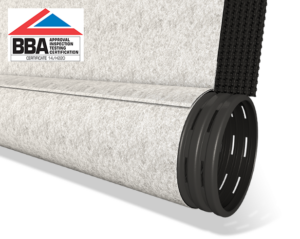
The Type 8 Fin Drain is supplied as a geotextile wrapped corrugated pipe, but it is not complete without a full depth of Type B – 20-40mm drainage filter stone, and in reality this is often not factored into the construction estimates to obtain a true cost comparison.
Based on a drainage trench design of 900mm high x 225mm wide, the material quantities for a 1km run of drain and the direct cost and carbon1 savings are calculated as follows: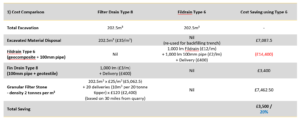
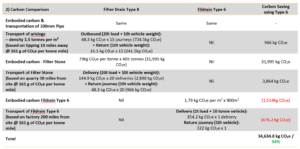
Geotextile filter
Both the Fildrain Type 6 and Type 8 methods channel the same volume of water via a 100mm diameter pipe to the drainage outlet. However, the 900mm high Fildrain Type 6 includes a textile surface area of 1.8 m2 to filter this volume of water, whereas the Type 8 only has 0.314 m2 of textile surface area wrapped around the circumference of the pipe. This places 6 x greater stress onto the Type 8 textile, and is therefore approximately 36 x more likely to clog than the Type 6 Fin Drain. See Filtration TECH NOTE for more information on geotextile clogging.
Flow performance
The water that enters the Fildrain Type 6 flows vertically down the entire width of the cuspated core and is then transported longitudinally along the pipe. As a result, holes can be cut through the fin on site if required without significantly affecting the flow performance. By comparison, gravel is not a particularly efficient drainage medium because the gravel itself takes up the majority of the volume. This is why a geocomposite, with a more direct flow path, is capable of transmitting an equivalent flow of water using a fraction of the volume. See Groundwater Drainage TECH NOTE for a comparison of flow capacity.
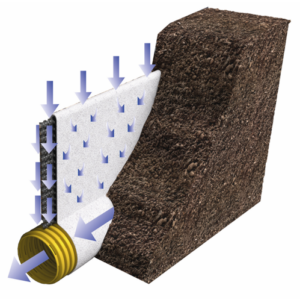
Conclusion
ABG Fildrain Type 6 provides flow capacity exceeding that of granular Type 8 drainage layers with just a fraction of the space required. This allows greater use of on-site materials and reduces the need to acquire and place suitable granular filter material. On sites where suitable granular drainage stone is not readily available this can lead to significant savings both in terms of the monetary cost (20% saving) and CO2 emissions (94% saving). The carbon associated with quarrying and delivering multiple loads of stone over even short distances is huge compared to that of just one delivery of Fildrain.
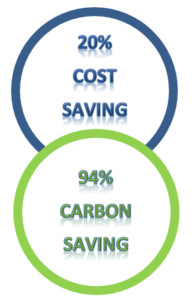
Notes
1. Sustainability achieved by the use of Fildrain Type 6
a) Great reductions in the use of stone which is a finite natural resource.
b) Saves on haulage – one load of Fildrain provides equivalent drainage to approx 100 loads of stone, thereby reducing pollution from exhaust emissions, wear & tear on highways and lowered local disturbance to residents due to less heavy vehicle traffic.
c) Since arisings are used to backfill the trench, it is not necessary to use wagons again for taking excavated material to tip.
d) Helps clients to achieve their stated Environmental Policies and Corporate Social Responsibility for sustainable development.